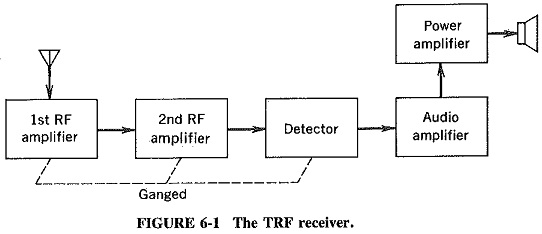Tuned Radio Frequency Receiver:
The Tuned Radio Frequency Receiver is a simple “logical” receiver. A person with just a little knowledge of communications would probably expect all radio receivers to have this form. The virtues of this type, which is now not used except as a fixed-frequency receiver in special applications, are its simplicity and high sensitivity. It must also be mentioned that when the Tuned Radio Frequency Receiver was first introduced, it was a great improvement on the types used previously mainly crystal, regenerative and superregenerative receivers.
Most radio receivers were of the TRF type, whose block diagram is shown in Figure 6-1.
Two or perhaps three RF amplifiers, all tuning together, weft employed to select and amplify the incoming frequency and simultaneously to reject all others. After the signal was amplified to a suitable level, it was demodulated (detected) and fed to the loudspeaker after being passed through the appropriate audio amplifying stages. Such receivers were simple to design and align at broadcast frequencies (535 to 1640 kHz), but they presented difficulties at higher frequencies. This was mainly because of the instability associated with high gain being achieved at one frequency by a multistage amplifier. If such an amplifier has a gain of 40,000, all that is needed is 1/40,000 of the output of the last stage (positive feedback) to find itself back at the input to the first stage, and oscillations will occur, at the frequency at which the polarity of this spurious feedback is positive. Such conditions are almost unavoidable at high frequencies and is certainly not conducive to good receiver operation.
In addition the Tuned Radio Frequency Receiver suffered from a variation in bandwidth over the tuning range. It was unable to achieve sufficient selectivity at high frequencies, partly as a result of the enforced use of single-tuned circuits. It was not possible to use double-tuned RF amplifiers in this receiver, although it was realized that they would naturally yield better selectivity. This was due to the fact that all such amplifiers had to be tunable, and the difficulties of making several double-tuned amplifiers tune in unison were too great.
Consider a tuned circuit required to have a bandwidth of 10 kHz at a frequency of 535 kHz. The Q of this circuit must be Q = f/Δf = 535/10 = 53.5. At the other end of the broadcast band, i.e., at 1640 kHz, the inductive reactance (and therefore the Q) of the coil should in theory have increased by a factor of 1640/535 to 164. In practice, however, various losses dependent on frequency will prevent so large an increase. Thus the Q at 1640 kHz is unlikely to be in excess of 120, giving a bandwidth of Δf = 1640/120 = 13.7 kHz and ensuring that the receiver will pick up adjacent stations as well as the one to which it is tuned.
Consider again a Tuned Radio Frequency Receiver required to tune to 36.5 MHz, the upper end of the shortwave band. If the Q required of the RF circuits is again calculated, still on this basis of a 10-kHz bandwidth, we have Q = 36,500/10 = 3650! It is obvious that such a Q is impossible to obtain with ordinary tuned circuits.
The problems of instability, insufficient adjacent-frequency rejection, and bandwidth variation can all be solved by the use of a superheterodyne receiver, which introduces relatively few problems of its own.
